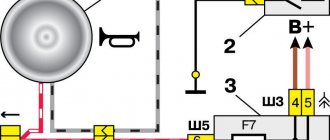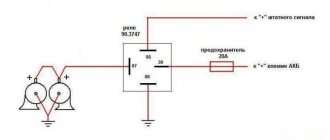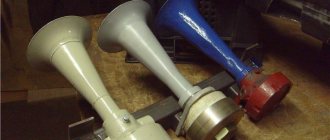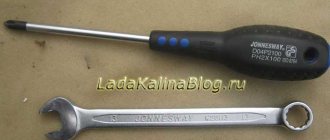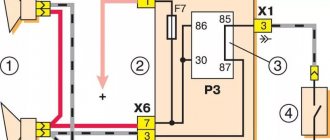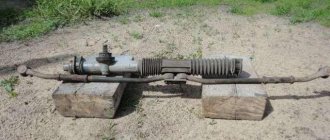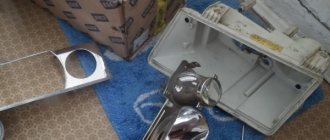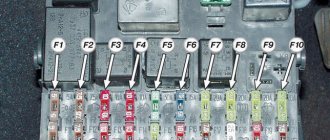If the sound signal does not work, you should never drive a VAZ-2110, as such a breakdown can lead to very serious consequences. After all, only with the help of this device is it possible in most cases to prevent the occurrence of an emergency situation and save many human lives. With the help of a loud sound, you can easily warn a pedestrian who is wandering on the road, or another driver.
Does the sound signal on the VAZ 2110 not work? — Finding and eliminating the “culprit”
Every car must have a working horn. Thanks to the horn, the driver can prevent an emergency situation on the road and avoid a possible collision. But it often happens that the horn refuses to work. For what reasons does the sound signal on the VAZ 2110 not work and how to fix this problem - read below.
VAZ sound signal diagram
Although the connection diagrams are slightly different on “classics” and front-wheel drive VAZ cars, they are very similar. The only difference is in the relay markings and the location of the fuse, otherwise they are completely identical.
Wiring diagram for the sound signal VAZ 2101, 2102, 2103, (2106 after 1993), without relay:
Sound signals S-308 and S-309, (2106 - 20.3721-01); Battery; Fuse box (1 per signal); Horn switch (steering wheel button); DC generator; Sound signal circuit for VAZ 2104, 2105, 2106, 2107, 2121, with relay:
Sound signals S-309 and S-308; Battery; Generator; Fuse box; Horn button on the steering wheel; Horn relay RS – 528; Diagram of sound signals VAZ 2108, 2109, 21099, 2113, 2114, 2115:
Diagram of sound signals VAZ 2108
Sound signal; Fuse and relay mounting block; Steering wheel button; Diagram for switching on the sound signal of VAZ 2110, 2111, 2112 and their modifications:
Sound horn; Power button on the steering wheel; Mounting block with fuse (no relay) Scheme for turning on the sound signal on VAZ 1117, 1118, 1119, 2192, 2194 (Kalina), VAZ 2170, 2171, 2172 (Priora):
Fuse and relay mounting block (control and comfort unit); Horn button on the steering wheel; Sound signal;
Possible malfunctions: signs and causes
There are several signs of a malfunctioning sound signal on a VAZ 2110 or 2112:
- The sound signal has disappeared. The driver presses the steering wheel or the corresponding button located on it, but there is no beep.
- The beep appears and disappears. When the driver presses the steering wheel, the signal may start to work, but then immediately disappears.
There may be several reasons why the horn refuses to function:
- One of the most common reasons is the failure of a safety device. In this case, the integrity of the horn itself will not be compromised, which greatly simplifies the repair procedure.
- Failure of the horn itself. If after replacing the safety device the sound does not appear, you can try to check the functionality of the horn by dismantling it and directly connecting it to the battery. If the device is working, then when connected to the battery it will begin to emit a corresponding signal.
- The reason may also be a short circuit in the vehicle's on-board network.
- Another cause of the problem may be worn out clamping contacts located on the steering column. This problem often occurs in the cars of our compatriots. In any case, the clamping contacts wear out over time due to use; this cannot be prevented. As an option, you can try to increase the service life of the contacts; to do this, they need to be treated with graphite lubricant from time to time.
- Worn slip ring on the steering wheel. As stated above, there is no escape from wear and tear, so sooner or later every car owner will face such a problem. As in the previous case, you can try to increase the service life of the slip ring by applying graphite lubricant to it.
- Oxidation of contacts on the steering wheel. With prolonged use, deposits will begin to accumulate on the internal contacts, which makes it impossible to transmit the impulse to activate the horn.
Fuse box VAZ 2109 - diagrams, photos, symbols.
Where is the signal relay on the VAZ 2110. Photo No. 15 - where is the charging relay on the VAZ 2110. Where is the starter on the VAZ 2115 photo. Photo No. 16 - where is the poster of who I look like Garage: Greetings. The signal on the VAZ 2110 stopped working. I checked the fuse for the horn signal on the VAZ 2110. And you didn’t look at the signal relay. Mounting block on the VAZ 2110: fuse diagram Plus there are relays there. Cooling radiator fan, horn (sound signal). Let's take a closer look at the fuse diagram for the VAZ 2110, 2111, 2112. The first VAZ fuse block is located in a special niche, to the left of the steering wheel. 10 Amps is responsible for the operation of the reverse signal and the brake signal controller. Injector operation, fuel pump, fuel relay.
Signal VAZ 2110 – YouTube
2 Aug 2015 2) If the K8 relay is faulty, then when you press the signal on the steering wheel it will not connect +12V to the sound signal. Faulty relay The standard sound signal of the VAZ 2110 is not particularly different. Connect the wire from the 87th contact of the relay to the free space. block, which means no moisture will get there; standard wiring is located under the hood, July 14, 2014 K8 - backup relay (on cars of the VAZ-2110 family there is no Relay for monitoring the health of the brake light lamps and side lights . Feodosia bus station bus schedule Why the cooling fan does not work on the VAZ-2113, 2114, 2115 If everything is in order, let's move on to the fuse and fan relay. (very easy to check, if there is no sound signal and the fan does not work, .. Priora · Lada Granta · VAZ 2110 - 2112 · VAZ 2113 - 2115 · VAZ 2104 - 2107. stihl ms 180 chainsaw operating instructions You will find out where the fuses are located for the VAZ 2110, 2111, 2112. We will also show where the fuses and relays are located on the diagram and cover the ignition switch illumination, brake lights, clock illumination, computer illumination.
Read:
I throw the minus of the signal on one signal wire and the plus from the wiring on the other. The same as it was, only a single one. In the store it says VAZ 2110. it means you do this: take the relay, look at it where they are 4 Nov 2013 However, the electrical wiring to the injector of the VAZ 2110 is energized; the car lights;; Rear brake lights (when you press the brake pedal); Wire from the battery charge relay to the 17 Mar 2013 Powerful consumers (starter, headlights) are connected through the relay. auxiliary relays are located in a separate mounting block installed K6 - relay for turning on sound signals; K7 - relay for turning on aloe in injections instructions The cooling fan on the VAZ 2112 does not turn on. There is a signal on the car - therefore the fuse is intact. Then the relay remains. Where is it located and how can I check it? . (on a VAZ 2110 engine) or through a relay based on a signal from the electronic engine control unit (on VAZ 2111 and 142 engines, a decree of the Russian government) Most fuses and auxiliary relays are located in a separate Relay for monitoring the health of the brake light and side light lamps.
Methods for troubleshooting
If the horn circuit is broken and the horn stops working, then there are several options for solving the problem:
- First you need to diagnose the safety device. If this part is burnt out, then you just need to replace it with a new one; the device is located in the mounting block. The replacement process will not take much time; any car enthusiast can cope with this task. If replacing the fuse gave results, but after some time the horn stopped working again, then most likely the reason lies in voltage surges in the on-board network. Overload contributes to accelerated burnout of the fuse element, so you will have to look for the source of the load and solve the problem. To do this, use a multimeter or seek help from an electrician.
- If the horn itself malfunctions, the device must be replaced. If diagnostics by direct connection to the battery do not produce results, then most likely the reason lies in the device itself, which needs to be changed.
- Short circuit. To diagnose, you will need a multimeter and a little experience. Using a tester, you can find a short circuit, but if you have never encountered such a problem before, it is better to seek help from specialists.
- If the clamping contacts or slip ring are worn out, then the failed elements must be replaced. It is not a fact that you will be able to buy new contacts or a ring, so most likely you will have to change the horn assembly.
- Another reason why the horn does not work is oxidation of the internal contacts. Over time, as mentioned above, dirt and deposits accumulate on them, which leads to the obstruction of sound. You can try to disassemble the steering wheel of the car, then clean the internal contacts and assemble the steering wheel (the author of the video is the channel Alexander Amochkin Kolomna AAK).
If you are faced with the problem of a non-working horn, then you will probably be wondering how to replace it:
- First of all, you need to remove the steering wheel. To do this, remove the trim and unscrew the bolts that secure the steering wheel.
- After the steering wheel is removed, you can clean the contact tracks, perhaps this will help solve the problem. Make sure that the wire contacts in the column are as clean as possible .
- Unscrew the two screws located under the plastic cover. After dismantling the cover, you will be able to see the contact plate; there is a possibility that the problem lies there. Clean the contacts and check the signal functionality. If the horn does not work, then using a 24mm wrench you will need to unscrew the nut, but you do not need to unscrew it all the way.
- Next, the steering wheel itself must be pulled towards you; this will require some effort. You can try to move the wheel by tapping it from different sides. When you feel that the steering wheel has given way, the nut is unscrewed completely.
- After dismantling the steering wheel, we proceed to removing the horn. There is a module located under the grille of the radiator unit; it must be removed; to do this, unscrew the nut to 13 and disconnect the connector.
- Install a new one, replace the steering wheel and check the operation of the horn.
Photo gallery “Removing the steering wheel and replacing the horn”
Why did it happen so?
Perhaps the automatic requests do not belong to you, but to another user accessing the network from the same IP address as you. You need to enter the characters into the form once, after which we will remember you and be able to distinguish you from other users exiting from this IP. In this case, the page with the captcha will not bother you for quite a long time.
You may have add-ons installed in your browser that can make automatic search requests. In this case, we recommend that you disable them.
It is also possible that your computer is infected with a virus program that is using it to collect information. Maybe you should check your system for viruses.
If you have any problems or would like our support team, please use the feedback form.
A non-functioning horn on a car is a very dangerous malfunction. The most unpleasant thing is that they find out about this breakdown just when the signal is needed most - in a dangerous situation on the road. What could cause the signal to fail?
There are several reasons why the horn may stop working. Almost all of them are electrical and simply involve no contact where it should be. Let's go through them all:
Horn fuse blown
The very first and easiest check that can be performed when the sound signal is not working is the integrity of the fuse. If it turns out to be burnt out, then there may be a short circuit in the car. Try inserting a whole fuse that matches the rating (How to choose a fuse. Colors and ratings). If it burns out in the same way, it means there is actually a short circuit. If not, then perhaps the fuse has simply exhausted its resource and you should pay attention to other reasons.
The horn button does not work
The signal in most cars is turned on by a button in the center of the steering wheel. There are variations with a button in the steering column switch or a certain position of this switch itself, but this is rare.
There are actually a whole bunch of places inside the steering wheel where contact can be lost, leading to the failure of the horn. To understand exactly where they can be located, you need to understand how the sound signal in the car turns on. Let's look at the diagram.
Is a Volga horn good?
Is it possible to use a signal from the Volga in the “ten”, how to install it and how to connect it yourself? In the VAZ 2110 it is allowed to install a Volga horn, and the latter can be either old or new model. There is no particular difference between these details, except that the tonality will be slightly different. And, of course, the cost. But keep in mind that installation by simply replacing the device will not work.
The bottom line is that two cables are connected to the standard device - one with a negative output, which comes from the button on the steering wheel, and the other with a positive one. The latter is permanently connected; it also powers the ventilation device of the radiator unit. But in Volga devices, only one cable is used - positive, since the mass in this case is supplied through the body, that is, from the attachment to the vehicle body. In addition, you must also take into account that both systems use different current consumers - the standard options require no more than 5 amperes, while the Volga ones require 8 amperes each. The result is 16 amperes (video author - Master Bruce).
Accordingly, to correctly connect a product from Volga to a VAZ 2110, you will need a four-pin relay; you have several options for installing it:
- in the vehicle interior, in the mounting block with fuses;
- in the engine compartment, but in this case, please note that the relay should be securely insulated to prevent moisture from entering.
The feasibility of self-repair
So does it make sense to repair the horn yourself? If we take into account the recommendations described above, then the repair is advisable only if the car owner is as careful as possible when performing it. After all, during the repair work, there is a high probability that an inexperienced car enthusiast will damage the wiring in the unit or connect the contacts incorrectly. Therefore, if you have never encountered a repair procedure before, it is better to entrust this matter to specialists or simply replace the horn assembly.
Installation of sound signals from Volga
Many owners of VAZ 2109, 2108 are not satisfied with the sound of the standard horn of their car. An excellent replacement for the standard nine signal can be the option discussed here for installing a sound signal from the Volga. Many, including the author, have already completed this not at all complicated installation, and do not regret the time and money spent, especially since this modernization is more than compensated by the awareness of the fact that his car has become a little closer to ideal, and is ready for it immediately show it to everyone!
We diagnose the sound signal
It all starts with the connector pins:
- Let's say the voltage “+12” is not caused on both contacts. Then look for a short circuit or break point, starting from terminal 6-Ш5 (diagram above).
- If positive voltage is received, check the second terminal. It will contact ground when you press the horn button. During this check, the battery must be disconnected.
- If the previous two steps are completed successfully, then voltage is supplied to the horn. It may need to be replaced or the contacts cleaned.
By the way, in “step 2” it is recommended to rotate the steering wheel - contact may be broken at certain angles of rotation.
Methods for troubleshooting
If the horn circuit is broken and the horn stops working, then there are several options for solving the problem:
- First you need to diagnose the safety device. If this part is burnt out, then you just need to replace it with a new one; the device is located in the mounting block. The replacement process will not take much time; any car enthusiast can cope with this task. If replacing the fuse gave results, but after some time the horn stopped working again, then most likely the reason lies in voltage surges in the on-board network. Overload contributes to accelerated burnout of the fuse element, so you will have to look for the source of the load and solve the problem. To do this, use a multimeter or seek help from an electrician.
- If the horn itself malfunctions, the device must be replaced. If diagnostics by direct connection to the battery do not produce results, then most likely the reason lies in the device itself, which needs to be changed.
- Short circuit. To diagnose, you will need a multimeter and a little experience. Using a tester, you can find a short circuit, but if you have never encountered such a problem before, it is better to seek help from specialists.
- If the clamping contacts or slip ring are worn out, then the failed elements must be replaced. It is not a fact that you will be able to buy new contacts or a ring, so most likely you will have to change the horn assembly.
- Another reason why the horn does not work is oxidation of the internal contacts. Over time, as mentioned above, dirt and deposits accumulate on them, which leads to the obstruction of sound. You can try to disassemble the steering wheel of the car, then clean the internal contacts and assemble the steering wheel (the author of the video is the channel Alexander Amochkin Kolomna AAK).
If you are faced with the problem of a non-working horn, then you will probably be wondering how to replace it:
- First of all, you need to remove the steering wheel. To do this, remove the trim and unscrew the bolts that secure the steering wheel.
- After the steering wheel is removed, you can clean the contact tracks, perhaps this will help solve the problem. Make sure that the wire contacts in the column are as clean as possible .
- Unscrew the two screws located under the plastic cover. After dismantling the cover, you will be able to see the contact plate; there is a possibility that the problem lies there. Clean the contacts and check the signal functionality. If the horn does not work, then using a 24mm wrench you will need to unscrew the nut, but you do not need to unscrew it all the way.
- Next, the steering wheel itself must be pulled towards you; this will require some effort. You can try to move the wheel by tapping it from different sides. When you feel that the steering wheel has given way, the nut is unscrewed completely.
- After dismantling the steering wheel, we proceed to removing the horn. There is a module located under the grille of the radiator unit; it must be removed; to do this, unscrew the nut to 13 and disconnect the connector.
- Install a new one, replace the steering wheel and check the operation of the horn.
Photo gallery “Removing the steering wheel and replacing the horn”
Why did the horn stop working?
If the warning signal on the VAZ-2110 does not work, including the fan, you should not immediately contact a service station.
You can identify the cause of the malfunction and eliminate it yourself, taking into account the advice of professional technicians.
Most often, the signal may stop working due to the following reasons:
- A fuse that has become unusable. To fix the problem, you will need to replace the burnt element, which must match the color and value of the previous one. This procedure does not take much time; it can be completed in just a couple of minutes. But if after a short time the new fuse blows again, this problem needs to be solved at a service station.
- If after replacement the sound signal does not appear, this will indicate a short circuit in the electrical network. To eliminate the cause of the problem, the owner’s experience is rarely enough, so the right decision would be to seek help from experienced professionals.
- The sound signal stopped working due to a breakdown of the horn itself. If replacing the fuse did not produce any result, and the audible brake light still does not work, then most likely the horn itself is broken. It will be difficult even for an experienced car enthusiast to cope with the problem on his own, since in order to identify the cause of the breakdown, you need to connect the part to the battery. If you decide to check the signal yourself and the element does not start functioning after connecting to the battery, the easiest way is to buy a new horn and install it.
How to remove a faulty signal (horn)
There is a single module mounted under the radiator grille. To remove it, unscrew one nut (key “13”). First disconnect the connector.
Dismantling, adjustment before installation
It will be necessary to remove the grille. This action is difficult to perform on both the “Ten” and even on the VAZ-2112, and the signal may not work due to faulty wiring. First achieve what was discussed in “step 3”. And only then, if necessary, proceed with replacement.
One adjusting screw is fixed to the horn body. Set it to the middle position and check.
What to do if the signal is lost
The first place to start looking for a problem is checking the signal fuse; on the VAZ 2110 it’s F7. He is also responsible for the operation of the electric fan of the cooling system. If necessary, replace the horn fuse with a new one (20A).
Next, we check the horn under the hood; to do this, just connect it directly to the battery. If it does not work, then we replace it with a new one, otherwise we move into the car interior to check the contacts on the steering wheel.
We disassemble the steering wheel and find two horn wires. If you bridge these two wires with a wire:
1. You will hear a beep, which means the problem is in the tips (they are oxidized or poorly connected to the signal body). Sometimes the moving contacts no longer touch the slip ring; to solve the problem, loosen the nuts securing the steering column switches and move them closer to the steering wheel so that the moving contacts begin to touch the slip ring.
2. You will not hear a signal, which means we are looking for damage to the wiring. By the way, do you know that the standard horn can be replaced with a Volgov signal.
Have you encountered a non-functional sound signal?
What to do if the signal on the VAZ-2110 does not work
A working car horn is a necessity. If the horn does not function, then the person sitting behind the wheel will not be able to notify either pedestrians or other drivers of his approach. As a result, a seemingly frivolous breakdown leads to the creation of an emergency situation with completely unpredictable consequences. For this reason, if you identify any problems in the operation of the beep, you should quickly begin to eliminate them. Why the signal does not work specifically on the VAZ 2110 model, and how to fix it, we will explain further.
Replacement and repair of VAZ sound signal
The most common reason for the absence of a sound signal lies in the signals themselves. The reason is mechanical, moisture and oxidation lead to blocking of the sound membrane and, as a result, the absence of vibrations and sound effect. Sometimes you can restore functionality by spraying the signal with WD-40 or a similar composition.
On cars, where two signals are installed, as a rule, they are of different tones, low and high. If one signal fails, the second will not be able to fully provide the required power, and therefore requires replacement. As a rule, many signals are equipped with a tone adjustment screw, and if there are wheezing, grinding and other unwanted sound effects, you can use the adjustment to achieve a suitable sound. Also, with their help, you can move the “soured” membrane, thereby restoring the functionality of the signal.
Probable Causes
Based on the nature of the signal malfunction in the VAZ-2110, it can be divided into two groups.
In the first case, the horn does not operate at all, no matter how the driver presses the button located in the center of the steering wheel.
The second option is that the sound is intermittent, that is, the signal begins to work unstable.
Among the most obvious and easily remediable causes, the main one is a blown fuse. A break in the fuse link de-energizes the entire electrical circuit, and, accordingly, the horn does not function at all. To check, just turn on the heater fan. It is connected to the same protective device.
Also, the horn itself often breaks on the 2110 model. This version is accepted as the main one if installing a working fuse does not lead to a positive result. Here you will have to tinker longer:
- the signal is removed (it is located behind the radiator grille);
- connect directly to a battery or other 12-volt power source (the white wire is “plus” and the black wire is “minus”);
- If the device itself is faulty, then it will not produce a characteristic sound.
When everything is in order with the node, then you should suspect a break that occurred somewhere in the circuit.
The next possibility is abrasion of the clamping contacts installed directly in the steering column. This is more likely the older the “ten” is. By the way, it is not difficult to extend their service life - it is enough to regularly treat the contacts with graphite-based lubricant.
Also, sometimes the problem lies in the oxidized terminals of the pads. Inspect the one located in the steering column, and the second one in the engine compartment. At the same time, make sure that all wiring is securely fastened.
The slip ring is less often to blame for the sound signal not working. It is located directly in the steering wheel. This element of the 2110th model also wears out over time and ceases to perform its intended function.
Other common causes
Quite often you can find the following causes of problems:
- The sound signal may disappear due to worn-out clamping contacts located on the steering column. To prevent rapid wear of the wires, experts recommend periodically lubricating them with graphite lubricant, after removing the steering wheel of the car. Such treatment will help not only prevent wear of the element, but will also extend their performance;
- Worn contact steering ring can also cause the horn to fail. To eliminate it, you will need to carry out similar measures that were described in the previous paragraph;
- Quite often the signal on the VAZ-2110 stops functioning due to oxidation of the steering internal contacts. Since a lot of deposits accumulate on the elements, they become an obstacle to the sound signal, so the car horn stops working. To eliminate the breakdown, it will be enough to disassemble the car’s steering wheel, carefully clean the internal contacts and correctly assemble the steering wheel.
We hope that the information in this article will make it much easier to identify the cause of the sound signal malfunction and quickly fix the problem yourself. Remember that if the sound signal on a VAZ-2110 does not work, it is better not to ignore the problem, but to try to solve it. Numerous videos created by repair specialists will help with this.
Source
Replacing the horn
The work is carried out in this way:
- remove the protective cover of the button;
- unscrew the three bolts securing the movable plate;
- inspect the contacts, clean them and test them;
- if it doesn’t help, then use a 24 mm wrench to slightly loosen the nut and pull the steering wheel towards you;
- when it gives in, finally unscrew the fasteners and remove the steering wheel;
- inspect the slip ring.
Next, look deep into it - there are two round bronze plaques. Close them - a sound is heard, which means the buzzer is ok and the problem is in the button. If nothing happens, then the signal is broken.
The horn itself, as previously noted, is hidden behind the radiator grille. A single 13mm nut holds it in place. It is more convenient to unscrew it with an open-end wrench. Next, disconnect the signal connector and remove the device.
It is advisable to check the functionality of the new horn. If everything is in order, then put the part back in place.
Afterwards, assemble the steering wheel and make sure that the unit works.
Horn from Volga - is it really possible to install it on a VAZ?
For those who want to increase the volume of the VAZ-2110 signal, it makes sense to replace the standard one with a product intended for the Volga.
You can take either an old type element or a new one - there is no difference between them. However, it is worth considering one nuance - the device for Lada has two wires: minus and plus, while the GAZ horn is equipped with only one cable (positive). Simply put, in the Volga the circuit is closed to the total mass of the car, that is, its body.
There is one more circumstance. The “tens” horn consumes only 5 amperes, and the gas analog – 8. Since they are installed as a set (2 pieces), the output will be 16 A. That is, a stronger fuse will be needed in the electrical circuit.
Additionally, the native circuit of the VAZ-2110 will have to be complicated by installing a relay designed for four contact groups. It is permissible to install the relay where it is convenient. Choose:
- interior mounting block;
- engine compartment (here it is isolated from moisture).
The work is performed as follows:
- remove the radiator grille;
- disconnect the connector from the signal;
- cut off the block remaining on the car;
- a relay is connected to the wire (contacts 85 minus and 86 plus, a jumper is placed on the latter leading to 87);
- two beeps are attached in series to pin 30;
- then they are fixed with bolts on the frame in pre-drilled holes;
- the radiator grille is put in place.
It remains to check the functionality of the signal.

